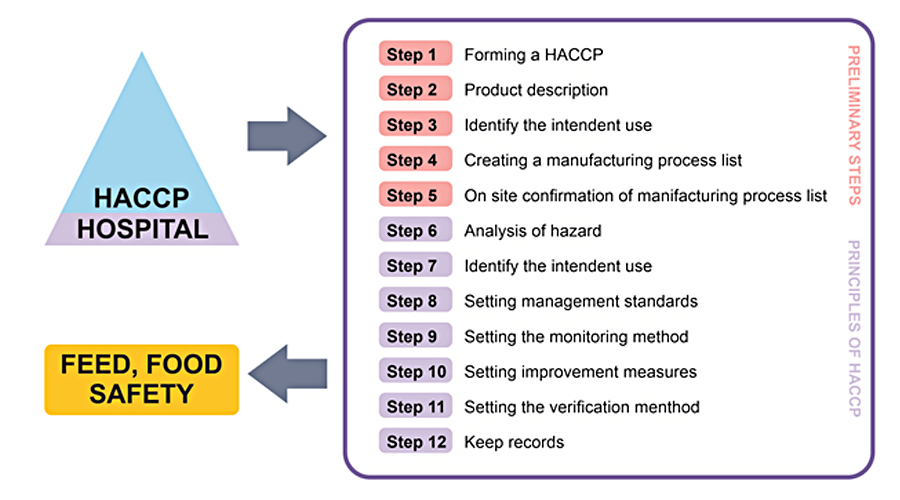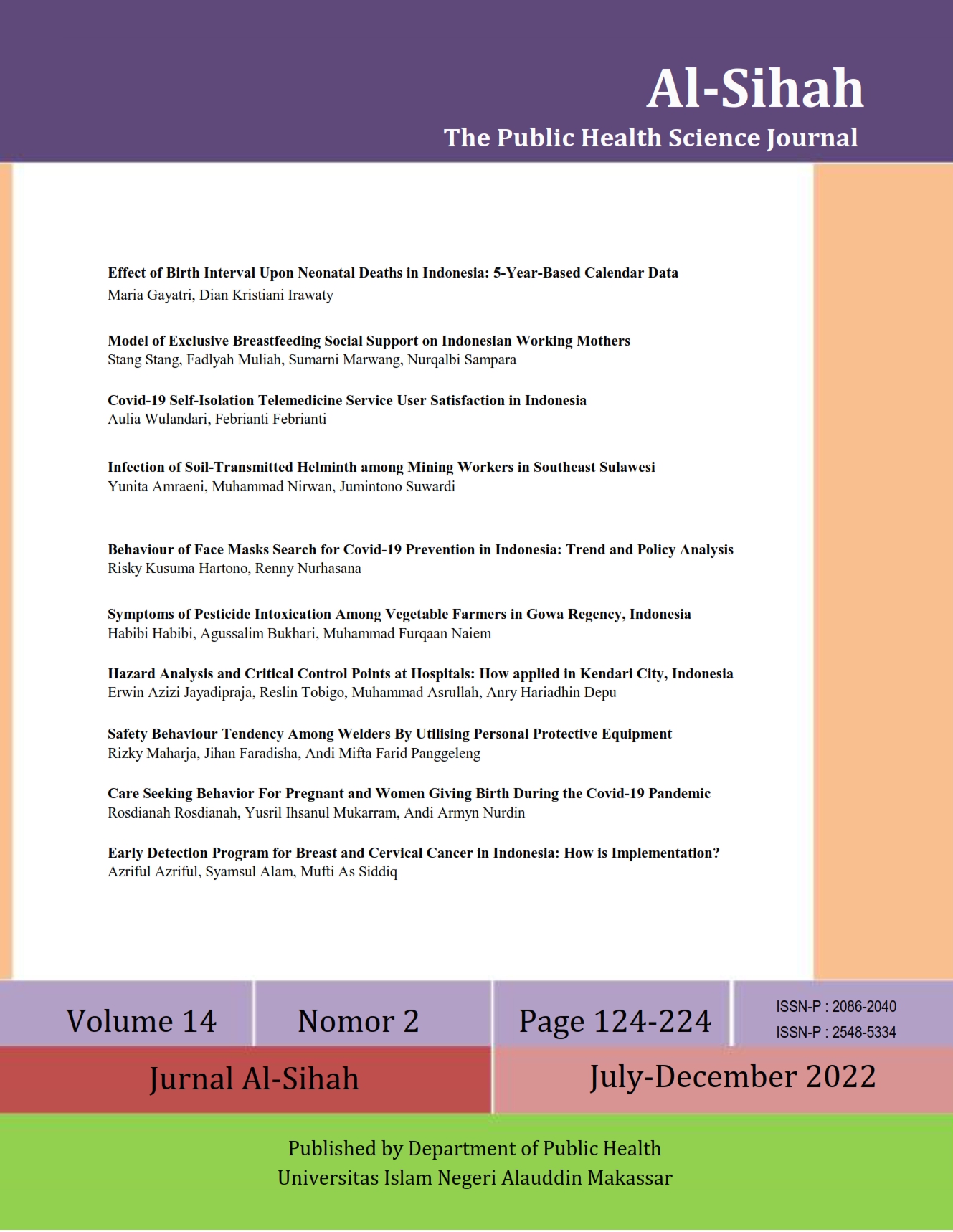Hazard Analysis and Critical Control Points at Hospitals: How applied in Kendari City, Indonesia
Abstract
Unsafe food for consumption can cause disease for humans, such as food poisoning and nosocomial infections. This study aimed to describe the implementation of Hazard Analysis and Critical Control Points (HACCP) in Hospitals in Kendari City, Indonesia. This study used analytical descriptive approach, with a survey design. It was conducted at General Hospital Bahteramas and in Kendari City General Hospital. The respondents were part of the nutrition staffs, hosts, and waiters with total of 25 people from Bahteramas General Hospital and 19 people from Kendari City General Hospital. The results revealed that the implementation of HACCP in hospitals had never been implemented effectively, at the Bahteramas General Hospital, the implementation of HACCP starting from stage 1 to stage 12 had not been entirely implemented. In addition, whilst the application of HACCP in stages 2 to 5 had been carried out at the Kendari City Hospital, the 1 and steps 6 through 12 were not applied yet. Thus, based on the concepts of food hygiene and sanitation, the hospitals must strengthen their food management efforts, in order to implement the HACCP system and for health workers, food handlers, and food servicers.

Downloads
References
Abd Aziz, N. A. S., Teng, N. I. M. F., Abdul Hamid, M. R., & Ismail, N. H. (2017). Assessing the nutritional status of hospitalized elderly. Clinical interventions in aging, 1615-1625. https://doi.org/10.2147/CIA.S140859
Adibi, S., Afshari, A., Norouzy, A., Nematy, M., Ehsani, A., & Hashemi, M. (2022). Microbiological quality of hospital‐prepared blenderised tube feeding. Journal of Human Nutrition and Dietetics. https://doi.org/10.1111/jhn.13066
Al-Busaidi, M. A., Jukes, D. J., & Bose, S. (2017). Hazard analysis and critical control point (HACCP) in seafood processing: An analysis of its application and use in regulation in the Sultanate of Oman. Food control, 73, 900-915. https://doi.org/10.1016/j.foodcont.2016.09.042
Allard, J. P., Keller, H., Jeejeebhoy, K. N., Laporte, M., Duerksen, D. R., Gramlich, L., Teterina. A., & Lou, W. (2016). Decline in nutritional status is associated with prolonged length of stay in hospitalized patients admitted for 7 days or more: A prospective cohort study. Clinical nutrition, 35(1), 144-152. https://doi.org/10.1016/j.clnu.2015.01.009
Allata, S., Valero, A., & Benhadja, L. (2017). Implementation of traceability and food safety systems (HACCP) under the ISO 22000: 2005 standard in North Africa: The case study of an ice cream company in Algeria. Food Control, 79, 239-253. https://doi.org/10.1016/j.foodcont.2017.04.002
Alrasheed, A., Connerton, P., Alshammari, G., & Connerton, I. (2021). Cohort study on the food safety knowledge among food services employees in Saudi Arabia state hospitals. Journal of King Saud University-Science, 33(6), 101500. https://doi.org/10.1016/j.jksus.2021.101500
Anthias, F. (2022). Ethnicity, class, gender and migration: Greek-Cypriots in Britain. Taylor & Francis.
Bader, F., & Jagtap, S. (2020). Internet of things-linked wearable devices for managing food safety in the healthcare sector. In Wearable and Implantable Medical Devices (pp. 229-253). https://doi.org/10.1016/B978-0-12-815369-7.00010-0
Bano, S. A., Hayat, M., Samreen, T., Asif, M., Habiba, U., & Uzair, B. (2020). Detection of pathogenic bacteria Staphylococcus aureus and Salmonella sp. from raw milk samples of different cities of Pakistan. Natural Science, 12(05), 295. https://doi.org/10.4236/ns.2020.125026
Barba, F. J., Terefe, N. S., Buckow, R., Knorr, D., & Orlien, V. (2015). New opportunities and perspectives of high pressure treatment to improve health and safety attributes of foods. A review. Food Research International, 77, 725-742. https://doi.org/10.1016/j.foodres.2015.05.015
Barrere, V., Everstine, K., Théolier, J., & Godefroy, S. (2020). Food fraud vulnerability assessment: Towards a global consensus on procedures to manage and mitigate food fraud. Trends in Food Science & Technology, 100, 131-137. https://doi.org/10.1016/j.tifs.2020.04.002
Berry, E. M., Dernini, S., Burlingame, B., Meybeck, A., & Conforti, P. (2015). Food security and sustainability: can one exist without the other?. Public health nutrition, 18(13), 2293-2302. https://doi.org/10.1017/S136898001500021X
Bhunia, A. K. (2018). Foodborne microbial pathogens: mechanisms and pathogenesis. Springer. http://www.doi.org/10.1007/978-1-4939-7349-1
Carino, S., Porter, J., Malekpour, S., & Collins, J. (2020). Environmental sustainability of hospital foodservices across the food supply chain: a systematic review. Journal of the Academy of Nutrition and Dietetics, 120(5), 825-873. https://doi.org/10.1016/j.jand.2020.01.001
Chen, H., Liou, B. K., Chen, C. S., & Chuang, P. T. (2020). Risk analysis method used in small-and medium-sized food enterprises implementing ISO 22000: 2018 and HACCP to conditionally determine “inspection-acceptance” as a critical control point. Accreditation and Quality Assurance, 25(5), 339-354. https://doi.org/10.1007/s00769-020-01447-3
do Rosario, V. A., & Walton, K. (2020). Hospital food service. Handbook of Eating and Drinking: Interdisciplinary Perspectives, 1007-1033. https://doi.org/10.1007/978-3-030-14504-0_74
Domínguez, R. A., Espinosa, M. d. M., Domínguez, M., & Romero, L. (2021). Lean 6S in Food Production: HACCP as a Benchmark for the Sixth S “Safety”. Sustainability, 13(22), 12577. https://doi.org/10.3390/su132212577
Ellinda-Patra, M., Dewanti-Hariyadi, R., & Nurtama, B. (2020). Modeling of food safety knowledge, attitude, and behavior characteristics. Food Research, 4(4), 1045-1052. https://doi.org/10.26656/fr.2017.4(4).375
Fusco, V., Abriouel, H., Benomar, N., Kabisch, J., Chieffi, D., Cho, G. S., & Franz, C. M. (2018). Opportunistic food-borne pathogens. In Food safety and preservation (pp. 269-306). https://doi.org/10.1016/B978-0-12-814956-0.00010-X
Gehring, K. B., & Kirkpatrick, R. (2020). Hazard analysis and critical control points (HACCP). In Food safety engineering (pp. 191-204). Springer, Cham. https://doi.org/10.1007/978-3-030-42660-6_8
Glowicz, J., Benowitz, I., Arduino, M. J., Li, R., Wu, K., Jordan, A., & Gold, J. A. (2022). Keeping health care linens clean: underrecognized hazards and critical control points to avoid contamination of laundered health care textiles. American Journal of Infection Control, 50(10), 1178-1181. https://doi.org/10.1016/j.ajic.2022.06.026
Hoelzer, K., Switt, A. I. M., Wiedmann, M., & Boor, K. J. (2018). Emerging needs and opportunities in foodborne disease detection and prevention: From tools to people. Food microbiology, 75, 65-71. https://doi.org/10.1016/j.fm.2017.07.006
Hung, Y. T., Liu, C. T., Peng, I. C., Hsu, C., Yu, R. C., & Cheng, K. C. (2015). The implementation of a Hazard Analysis and Critical Control Point management system in a peanut butter ice cream plant. Journal of food and drug analysis, 23(3), 509-515. https://doi.org/10.1016/j.jfda.2015.02.005
Illés, C. B., Dunay, A., Serrem, C., Atubukha, B., & Serrem, K. (2021). Food Safety and Sanitation Implementation Impasse on Adolescents in Kenyan High Schools. International Journal of Environmental Research and Public Health, 18(3), 1304. https://doi.org/10.3390/ijerph18031304
Khan, H. A., Baig, F. K., & Mehboob, R. (2017). Nosocomial infections: Epidemiology, prevention, control and surveillance. Asian Pacific Journal of Tropical Biomedicine, 7(5), 478-482. https://doi.org/10.1016/j.apjtb.2017.01.019
Ko, W. H. (2013). The relationship among food safety knowledge, attitudes and self-reported HACCP practices in restaurant employees. Food control, 29(1), 192-197. https://doi.org/10.1016/j.foodcont.2012.05.076
Lahou, E., Jacxsens, L., Verbunt, E., & Uyttendaele, M. (2015). Evaluation of the food safety management system in a hospital food service operation toward Listeria monocytogenes. Food control, 49, 75-84. https://doi.org/10.1016/j.foodcont.2013.10.020
Lateefat, H. M., Sawyerr, H. O., Mubarakat, A., Yusuf, A. O., Yusuf, A. B., Opasola, O., & Suleiman, U. (2018). Hazard Analysis Critical Control Point (HACCP) Assessment of Regulated Premises: An Assessment of Standard Hotels in Ilorin Metropolis. Journal of Health and Environmental Research, 4(2), 56-68. http://www.doi.org/10.11648/j.jher.20180402.13
Lima, J., Teixeira, P. P., da Conceição Eckert, I., Burgel, C. F., & Silva, F. M. (2021). Decline of nutritional status in the first week of hospitalisation predicts longer length of stay and hospital readmission during 6-month follow-up. British Journal of Nutrition, 125(10), 1132-1139. https://doi.org/10.1017/S0007114520003451
Peerally, J. A., De Fuentes, C., & Figueiredo, P. N. (2019). Inclusive innovation and the role of technological capability-building: The social business Grameen Danone Foods Limited in Bangladesh. Long Range Planning, 52(6), 101843. https://doi.org/10.1016/j.lrp.2018.04.005
Southeast Sulawesi Provincial Health Office. (2020). Kendari Provincial Health Office Profile. Southeast Sulawesi.
Todd, E. (2020). Food-borne disease prevention and risk assessment. International journal of environmental research and public health, 17(14), 5129. https://doi.org/10.3390/ijerph17145129
Trafialek, J., & Kolanowski, W. (2014). Application of failure mode and effect analysis (FMEA) for audit of HACCP system. Food Control, 44, 35-44. https://doi.org/10.1016/j.foodcont.2014.03.036
Trafialek, J., & Kolanowski, W. (2017). Implementation and functioning of HACCP principles in certified and non-certified food businesses: A preliminary study. British Food Journal, 119(4), 710-728. https://doi.org/10.1108/BFJ-07-2016-0313
Vukman, D., Viličnik, P., Vahčić, N., Lasić, D., Niseteo, T., Krbavčić, I. P., & Bituh, M. (2021). Design and evaluation of an HACCP gluten-free protocol in a children's hospital. Food Control, 120, 107527. https://doi.org/10.1016/j.foodcont.2020.107527
World Health Organization. (2016). World health statistics 2016: monitoring health for the SDGs sustainable development goals. World Health Organization. https://apps.who.int/iris/handle/10665/206498
Zeb, A., Ayesha, R., Gilani, S. A., Shahbaz, M., Imran, A., El-Ghorab, A., El-massry, K. F., & Imran, M. (2020). Safety assessment of foods at capital hospital of pakistan through the hazard analysis and critical control point system. Journal of Food Protection, 83(8), 1387-1395. https://doi.org/10.4315/0362-028X.JFP-18-602
Copyright (c) 2022 Erwin Azizi Jayadipraja, Reslin Tobigo, Muhammad Asrullah, Anry Hariadhin Depu

This work is licensed under a Creative Commons Attribution-NonCommercial-ShareAlike 4.0 International License.
Authors retain copyright and grant the journal right of first publication with the work simultaneously licensed under a Creative Commons Attribution-NonCommercial-ShareAlike 4.0 International License that allows others to share the work with an acknowledgment of the work's authorship and initial publication in this journal.
Authors are able to enter into separate, additional contractual arrangements for the non-exclusive distribution of the journal's published version of the work (e.g., post it to an institutional repository or publish it in a book), with an acknowledgment of its initial publication in this journal.
Authors are permitted to publish their work online in third parties as it can lead to wider dissemination of the work.






